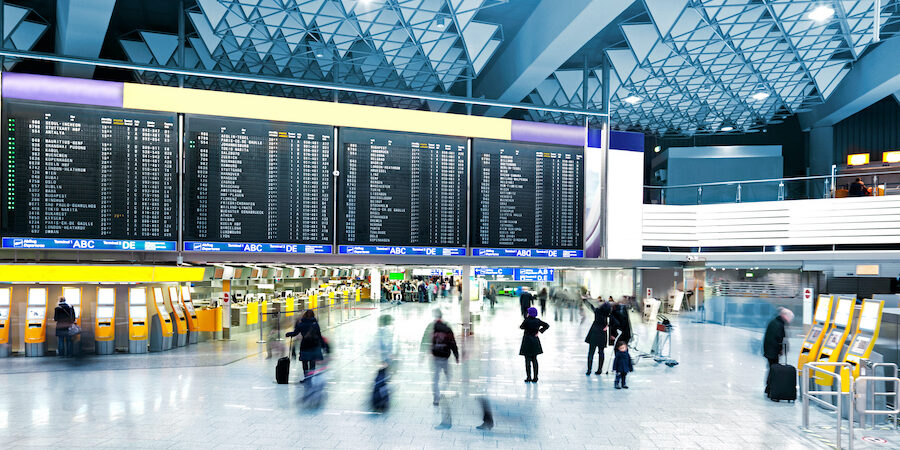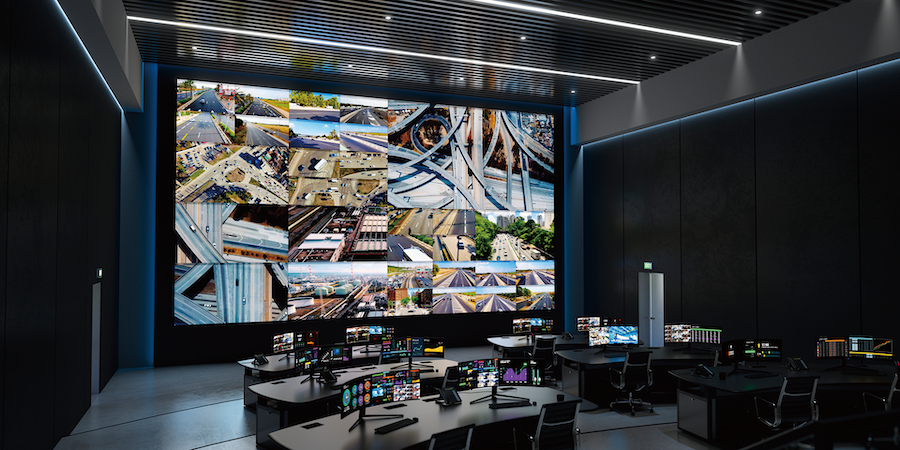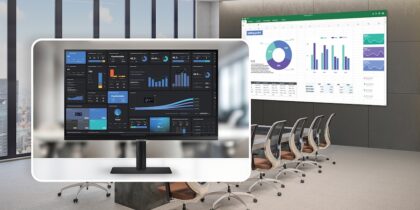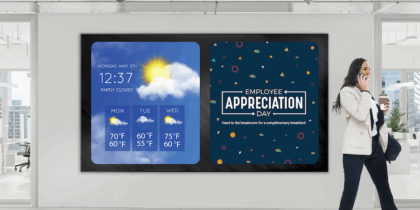Great decision making is guided by solid, real-time data. In team-based command and control center environments, video walls can serve as critical data hubs that everyone can see and use.
Public agencies and utilities operating at city, regional, state and federal levels employ 24/7 teams to keep the power grids active and streets safe, and those teams rely heavily on information that steadily pours in from management systems, cameras and connected sensors.
Desktop displays in control rooms can give operators with specific tasks a dashboard view of status, but large video walls provide a macro view that can be configured and switched as needed to empower situational awareness and help workers solve problems.
Getting the big picture
Nearly every control room and operations center has rows of desks equipped with monitors, so why do these facilities also need a video wall to display their information?
One reason is hierarchy: Individual operators may be tasked with monitoring and managing specific systems or responding to data streams coming from machines or sensors. Meanwhile, managers need to know what’s going on more broadly, but they also must have an immediate sense of mission-critical indicators that would otherwise be limited to operator desktops.
Streamline agency operations with digital signage
Get your free guide to enhancing public safety and operational efficiency using digital signage. Download Now
It works in reverse, as well. Operators focused on their specific systems and tasks can quickly look up to see the bigger story and understand whether what’s happening on their screens relates to indicators on other systems or to external factors, such as weather.
In many situations, having that big-picture view and the ability to share it with a team can make a huge impact downstream. When operators have access to real-time data and views, they can make informed decisions that could mean the lights in a city stay on, traffic keeps flowing or flights get safely diverted in the face of a looming storm.
Making informed decisions
Advancements in wireless connectivity, data systems and low-cost single-purpose devices have all contributed to a flood of available information.
In the past, control room displays were tied specifically to proprietary management and information systems on the same network. Now, information is available across much broader internal systems and also from countless external data sources that can contribute to better decision making. This has been augmented by an explosion in the use of camera systems to monitor everything from busy roadways to public plazas to transport hub entries. The city of Chicago, for example, has as many as 35,000 cameras it can tap into.
Layered onto that, artificial intelligence (AI) and machine learning can now provide real-time insights on the behavior patterns of large crowds. Consider, for instance, how the operations centers for a big city’s mass transport and first responder services could use video walls to monitor and respond to a momentous sporting event, such as game seven of a baseball or basketball playoff series.
The video wall could be segmented to show the broadcast of the game and monitor the remaining time, while multiple camera views could show crowd sizes at venue exit points. AI-driven heat mapping could analyze the people density, allowing police and EMS to assign units where they may be needed. City bus and rail systems, knowing that the game will end soon, could assign extra support to handle a rider spike and minimize platform crowding. Roads could be blocked or traffic light timings adjusted to handle the traffic rush. If cameras show trouble developing — such as jubilant fans flooding into intersections and blocking traffic — units can be diverted to that area.
All that data can live on small screens, but big screens can enable more immediate, team-driven decisions. With the right control and switching systems, specific views that aren’t always on a main screen can be pushed to a window or set to take up the full view in order to help guide the team’s choices and inform their next steps from minute to minute.
What to use
There are two core options for creating a visually commanding, highly changeable video wall in operational environments.
Narrow-bezel LCD displays deliver virtually seamless video walls that can pack 4K detail into individual display units. Pin-sharp displays provide all the granular detail needed to view information such as aerial and radar imaging properly.
LCD is particularly well-suited to environments with controlled, subdued lighting and use cases that involve reliable, fixed sets of views, such as monitoring traffic or surveillance cameras. Camera views can be aligned with the gridlines created by the super-thin bezels (frames) of the LCDs, making them effectively disappear.
Direct view LED displays, by comparison, deliver a seamless display canvas. The display cabinet design of LEDs has no frames, allowing units to be tiled and stacked to any dimension. They also have sufficient lighting power to overcome any lighting conditions.
While typical LCD and projection-based control rooms may have limited lighting and no windows so the screens can be easily viewed, direct view LED displays are visually vibrant, even in rooms filled with windows and natural light.
One consideration for operators is using display technology that supports remote power supplies, removing the physical footprint of the equipment, as well as the noise and heat, from the display area and locating it as far as 300 feet away in an IT closet or mechanical room.
A third option — Samsung’s microLED-driven The Wall — offers a solution for use cases that require visually rich, detail-heavy, unbroken visuals on a big canvas. The Wall’s micron-sized light pixels are set against high-contrast black backgrounds, resulting in crisp visuals that rival premium LCD panels in quality but have no gridlines.
As with more conventional LED, The Wall is modular and can be built to any shape or scale. It also comes in a set of fixed, preconfigured sizes as wide as 48 feet diagonal.
Video walls are a game-changer for public agencies charged with keeping traffic moving and citizens safe. Having an information-rich, real-time display can drive collaboration, increase efficiency and help guide smart decisions.
Learn how to streamline mission-critical workflows and content management in the control room using secure, large-format displays. Then be sure to find an LED provider who can ensure safety in their products.









